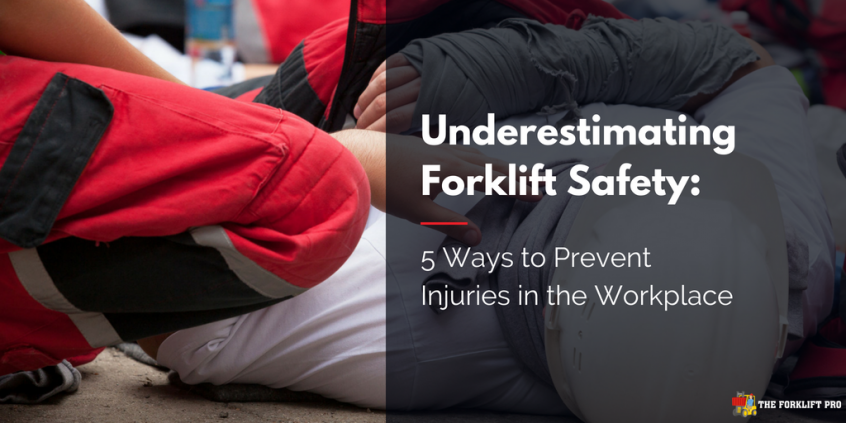Forklifts are distinct, powered vehicles that help us move large products and materials from one area to another on a daily basis. They are among the most frequently used pieces of equipment in the workplace, with more than 856,00 in operation throughout the United States.
While forklifts are beneficial in the workplace for various reasons, the dangers associated with them are often underestimated. According to the Occupational Safety and Health Administration (OSHA), approximately 100 deaths and roughly 34,000 injuries occur annually due to forklift-related incidents.
In an effort to reduce these numbers, it is important to implement the following forklift safety measures to ensure a safer working environment for employees.
Provide Training for Forklift Operators
The best way to protect employees from injury is to make sure they fully understand the fundamental regulations and safe practices of operating and maintaining their machinery. The proper forklift training will reduce and prevent accidents from happening in the workplace.
As an employer, it is required to provide OSHA-compliant training to employees who will be operating forklifts. Operators who complete OSHA-compliant safety training obtain a forklift license which certifies the operator can safely operate a forklift, as well as identify and avoid safety hazards. There is no guaranteed solution to stop forklift accidents, but requiring workers to get a forklift license can minimize the risk of workplace injuries.
Perform Daily Inspections on Material Handling Equipment
Operators should routinely inspect their forklifts before each shift to determine if their machine needs servicing. Inspecting essential utilities such as the horn, lights, coolant levels, hydraulics, brakes, steering and operating systems, are just some of the many components that should be checked prior to forklift use. These daily inspections can help prevent workplace injuries by identifying unsafe conditions before operating the forklift.
Employers should provide forklift operators with an inspection checklist which lists all components that require visual and operational checks each day before use. This documentation informs other operators and employees if a forklift requires any repairs. If the truck is found to be in need of repair or is in any way unsafe, it should be reported immediately to a supervisor, and the forklift should not be operated until repair and back in safe operating condition.
Be Aware of Carbon Monoxide
Forklifts powered by gasoline, propane and diesel fuel emit carbon monoxide in their exhaust. If you’re operating one of these forklifts inside or in confined spaces, you may be putting yourself at risk for carbon monoxide poisoning. Carbon monoxide poisoning occurs when carbon monoxide builds up in the bloodstream. When too much carbon monoxide is in the air, your body replaces the oxygen in your red blood cells with carbon monoxide.
Protect forklift operators and other employees from carbon monoxide poisoning by operating gas-powered trucks only in open, well-ventilated areas or outdoors. Electric-powered forklifts are best used indoors and confined spaces since they do not emit dangerous fumes.
Don’t Load Beyond Capacity
Simply, know the capacity of your forklift and any attachments being used, and never exceed this capacity. It is also important to ensure your load is evenly distributed. Forklifts can tip over easily if they are improperly loaded. In fact, 14 percent of all forklift accidents occur in this manner.
To handle a load safely, a forklift operator must consider all risks and dangers associated with loading and handling items on the forklift. There is also the risk of blind spots while moving loads and hazards on the ground when unloading. When lifting, moving, or lowering a load with a forklift, smooth operation is essential for maintaining stability.
Zero Tolerance Policy
No matter how experienced an operator may be, horseplay or reckless driving is not permitted. You can prevent most workplace accidents by being alert and following company safety guidelines. Consider enforcing disciplinary action to better protect your employees and to emphasize the seriousness of the offense. Operating a forklift is serious business, and accidents can happen at any time. Don’t underestimate the power of operating a forklift.
What to Do if You’re Involved in a Forklift Accident
According to OSHA regulations, every employer should have a plan in place in case of any accidents involving a forklift, or other material handling equipment. There are several different types of forklift “accidents,” including: operator error, defective equipment, tipping from improper loading or speeding.
If a forklift accident should occur, employers should follow OSHA guidelines. The first step is to seek medical attention if anyone was injured in the accident. Next, the accident should be reported. Employers should speak with witnesses, take photos where the accident took place, and comply with all OSHA reporting and recordkeeping regulations. Lastly, employers should train other employees on how to prevent another accident from happening.
To reduce the amount of accidents in your workplace, implement these safety measures in your workplace.

